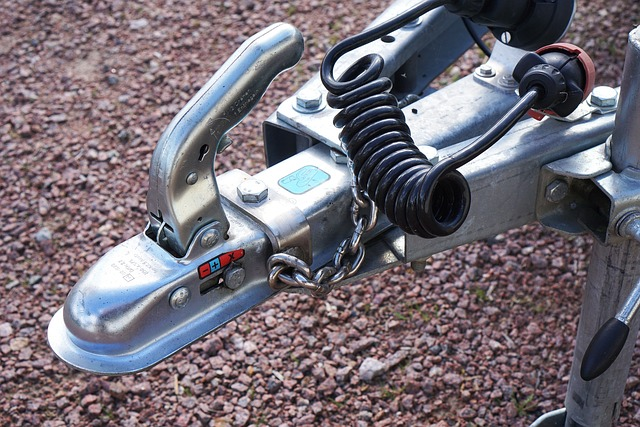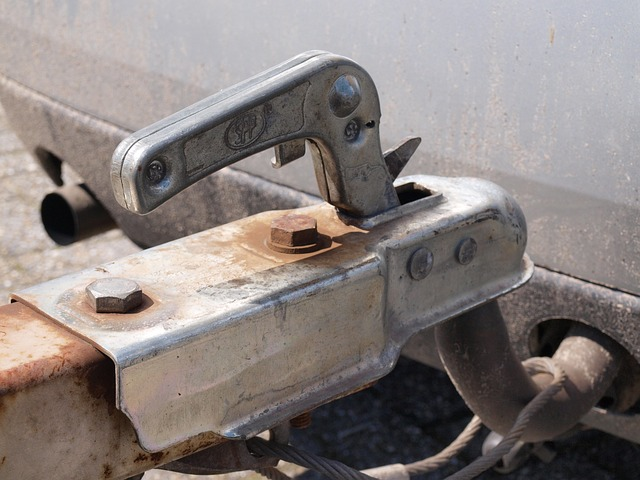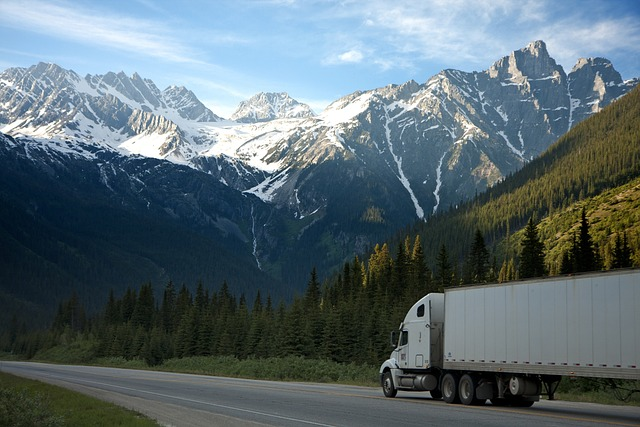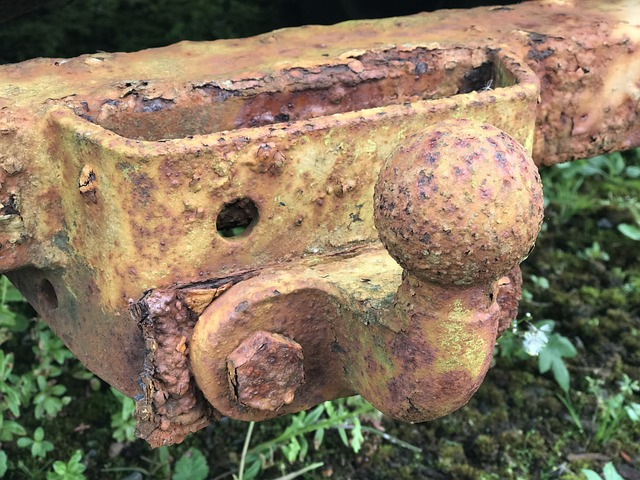Have you ever noticed a strange contraption attached to the back of a truck or an SUV? That odd-looking piece of metal is called a trailer hitch. Trailer hitches are useful for attaching trailers, boats, campers, and other vehicles. They come in various sizes and shapes and can be installed on any vehicle with sufficient strength to carry the extra load. In this blog post, we will take a closer look at trailer hitches and how they work.

Understanding the Different Types of Trailer Hitches
Adding a trailer hitch to your vehicle is a great way to expand the transportation options for your adventures. Have you ever found yourself searching for a way to attach a trailer to your vehicle? You may have come across the terms “trailer hitch” and “tow hitch,” but what’s the difference? Let’s clear up the confusion- a trailer hitch and a tow hitch are essentially the same thing. Both are used to attach a trailer to a vehicle.
Essentially, a hitch is a device that attaches to the frame of your vehicle and provides a connection point for a trailer or other towing equipment. So next time you’re looking for a way to tow your trailer, don’t worry about the terminology- just make sure you have a sturdy hitch that can handle the weight! A trailer hitch is an essential tool for towing anything from the family camper to a small utility or boat trailer. But before purchasing a hitch, it is important to understand the different types of trailer hitches available and their uses.
Receiver Hitch
The receiver hitch is the most common type of trailer hitch and is designed to fit onto the receiver tube of a vehicle’s frame. This type of hitch can carry up to 30,000 pounds and is available in different sizes, including class I, II, III, IV and V. Class I and II receivers are commonly used for compact cars and small SUVs, whereas class III, IV, and V are more commonly used for larger vehicles with a higher towing capacity. This type of hitch is popular for those towing a variety of trailers.
Fifth Wheel Hitch
Fifth-wheel hitches are intended primarily for use on pickups and larger trucks. The hitch bolts down to the bed of the truck and can sustain the weight of up to 30,000 pounds. This type of hitch attaches to the kingpin on the trailer and helps to distribute weight evenly, making it easy and safe to drive on long-distance trips. Fifth-wheel hitches are perfect for people who require a high towing capacity for their fifth-wheel trailers.
Gooseneck Hitch
The gooseneck hitch is a popular alternative to fifth-wheel hitches and attaches to the bed of a pickup truck. This type of hitch generally has a lower profile than the fifth-wheel hitch, and is designed for carrying heavier loads of up to 30,000 pounds. A gooseneck hitch is perfect for truck owners who need to haul a large amount of cargo or heavy equipment securely.
Pintle Hitch
Pintle hitches are designed for heavier loads, such as machinery and equipment. They are commonly used in the construction and agricultural industries. A pintle hitch is characterized by a ring-like attachment that is held in place by a hook or latch. This type of hitch is made for carrying loads of up to 60,000 pounds, making it a valuable tool for those who need to move larger machinery or equipment from one location to another.
Weight Distribution Hitch
A weight distribution hitch is designed to distribute the weight of a trailer to the front and rear axles of the tow vehicle. This type of hitch combines a weight-distribution system with the traditional ball and coupler to reduce trailer sway and improve control. Weight distribution hitches can be used for loads of up to 12,000 pounds and are a great choice for those who regularly tow heavy loads.
What is A Hitch Class?
If you’re in the market for a trailer hitch, you may have come across different “classes” of hitches. But what exactly is a hitch class? Essentially, it refers to the weight capacity of the hitch and its ability to support different types of trailers. There are five classes of hitches, with each class increasing in weight capacity. Class I hitches are most commonly used for smaller vehicles and lighter loads, while Class V hitches are reserved for heavy-duty trucks and trailers. When choosing a hitch, it’s important to consider your towing needs and ensure that you select the appropriate class to safely tow your cargo.

Understanding the Different Parts of a Trailer Hitch
If you’re planning to tow a trailer, you need a trailer hitch. A trailer hitch is a device that allows you to connect a trailer to your vehicle. It consists of several components and parts that work together to make towing a safe and efficient task. Understanding the different parts of a trailer hitch is essential to ensure that you choose the right one for your towing needs.
Trailer Hitch Receivers
The receiver is the part of the trailer hitch that attaches to the frame of your vehicle. It’s the component that supports the weight of the trailer and secures it to your vehicle. Receivers come in different sizes depending on the weight of your trailer. The most common receiver size is a 2-inch receiver, which can handle trailers up to 10,000 pounds. Larger trailers require larger receivers with more weight capacity.
Trailer Hitch Ball Mount
A ball mount is the part of the trailer hitch that holds the hitch ball. It slides into the receiver and is secured with a pin. The height and weight capacity of the ball mount should match your trailer’s tongue weight and height. Ball mounts come in different lengths and drop sizes, so it’s essential to choose the right one to keep your trailer level while towing.
Trailer Hitch Hitch Ball
The hitch ball is the spherical-shaped component on the end of the ball mount that connects to the trailer coupler. It comes in different sizes and weight capacities depending on your trailer’s weight and coupler size. The standard size for the hitch ball is 2 inches, which can handle trailers up to 5,000 pounds. Larger trailers require larger hitch balls with higher weight capacity.
Trailer Hitch Safety Chains
Safety chains are a crucial part of a trailer hitch that prevents the trailer from detaching from your vehicle. They attach to both sides of the trailer tongue and connect to the frame or bumper of your vehicle. Safety chains come in different lengths and weight capacities, and you need to choose the right ones that meet or exceed your trailer’s weight.
Trailer Hitch Wiring Harness
The wiring harness is the electrical connection between your vehicle and the trailer. It provides power to the trailer’s lights, brakes, and turn signals. You need to make sure that the wiring harness matches the wiring on your vehicle and is compatible with your trailer’s electrical system. Most trailers use a standard 4-pin or 7-pin wiring harness.

The Ultimate Guide on Choosing the Right Trailer Hitch
When it comes to towing anything behind your vehicle, choosing the right trailer hitch is crucial for both safety and practicality. But with so many different types of hitches available, things can get a little overwhelming. From weight classes and tongue weight to hitch receivers and ball mounts, there are a lot of factors to consider.
Determine the Correct Towing Capacity
The first and most important factor to consider is your vehicle’s towing capacity. This is the maximum amount of weight your vehicle can safely tow. Exceeding this weight limit can result in dangerous situations on the road, damage to your vehicle, and potentially violate local laws. To determine your vehicle’s towing capacity, check your owner’s manual or consult with the manufacturer. Make sure you consider other factors such as passengers, cargo, and fuel, which will also add weight to your vehicle. Once you have determined your towing capacity, you can then move on to choosing the appropriate hitch.
Choose the Correct Hitch Class and Size
Hitches are classified by weight capacity, ranging from Class I, which can tow up to 2,000 pounds, to Class V, which can tow up to 20,000 pounds. Your vehicle’s towing capacity will determine which class of hitch you need. Additionally, hitches also come in different sizes, so it’s important to match the size of the hitch with the size of the receiver on your vehicle. Common sizes include 1-1/4 inches and 2 inches, but you should check your vehicle’s owner manual to make sure.
Consider Tongue Weight and Gross Trailer Weight
In addition to towing capacity, tongue weight and gross trailer weight are important factors to consider when choosing a hitch. Tongue weight refers to the amount of weight pushing down on the hitch ball, while gross trailer weight refers to the total weight of your trailer and everything in it. It’s important to choose a hitch with a weight rating that exceeds the combined weight of your trailer and cargo. The tongue weight is just as crucial as the gross trailer weight, as it can affect the stability of your vehicle and the trailer.
Choose the Right Ball Mount
The ball mount is the component that attaches to the hitch receiver and provides a place for the trailer ball to be mounted. Choosing the right ball mount is important to ensure that the trailer is at the correct height to be towed safely and that the weight is distributed evenly. You must consider the drop or rise of the ball mount based on the height of the trailer and the towing vehicle.
Consider the Type of Trailer Being Towed
Finally, it’s worth considering the type of trailer you’ll be towing. Different types of trailers require different types of hitches. For example, fifth-wheel trailers require a specific type of hitch that’s mounted in the bed of a pickup truck. On the other hand, standard trailers require a receiver hitch mounted to the back of the vehicle. Furthermore, trailers with brakes may require a brake controller that can be added to your vehicle’s dashboard.

Installation of a Trailer Hitch
Installing a trailer hitch can be a bit tricky, and it’s best left to the experts. Many factors need to be considered, such as the vehicle’s make and model, the type of hitch being installed, and the towing capacity. It’s essential to ensure that the hitch is secured and that all parts are installed correctly before attempting to tow anything. A poorly installed hitch can lead to accidents and injuries.
Maintenance of a Trailer Hitch
Proper maintenance of a trailer hitch is vital to ensure it continues to work correctly. Regular inspections should be performed to check for any visible signs of wear and tear. Lubrication of all moving parts is also essential, and any damaged parts should be replaced immediately. Remember that your trailer hitch is only as strong as its weakest link, so it’s crucial to keep it in good working condition.
Conclusion
Trailer hitches are essential for many reasons and have several types, all with different functions. Choosing the right hitch, installing and maintaining it correctly is crucial for safe towing practices. It’s always best to seek professional advice before investing in a trailer hitch to ensure that you’re getting the right one for your needs. Remember that the safety of your load, the hitch, and your vehicle should always come first.

Interstate Haulers
At Interstate Haulers, we understand that sometimes you need a helping hand to haul heavy items. Whether you need light duty hauling or level towing, our experienced team is ready to assist you. Our customers’ satisfaction is our top priority, which is why we always ensure to securely transport your cargo with the help of our tow hooks and cargo carrier.
You can trust us to take care of your valued possessions and safely transport them to their destination. Don’t worry about the logistics – just reach out to us at Interstate Haulers and let us handle it all for you.




